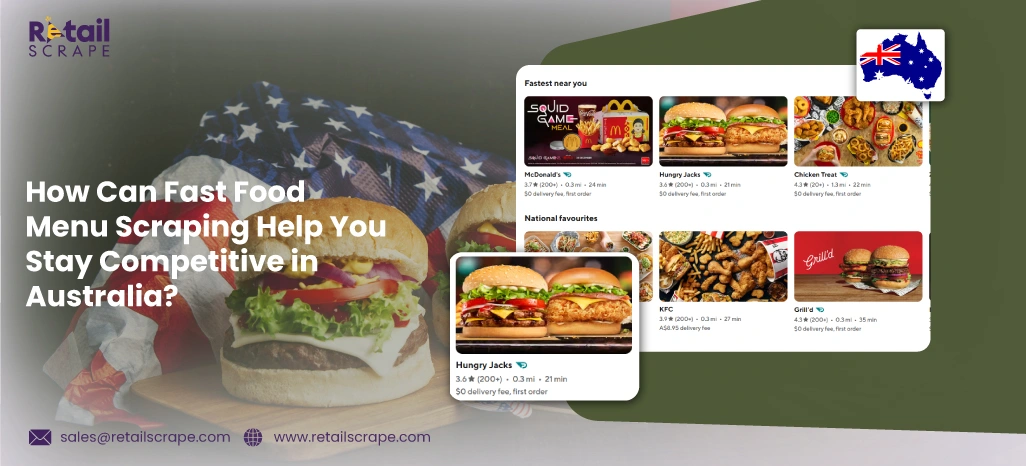
Introduction
The fast food industry in Australia continues to grow as consumers seek new meal options to match their busy lifestyles. The market is diverse and competitive, with a broad range of offerings from burgers to pizzas and wraps, making it a critical area for businesses and data analysts. Fast food menu scraping is essential for extracting valuable data about menu offerings, pricing strategies, and customer preferences. By scraping fast food menus in Australia, businesses can gain insights into trends, monitor competitor pricing, and adapt their menu to meet consumer demands. This data-driven approach allows businesses to stay ahead of the competition by optimizing product offerings and marketing strategies. In a fast-paced market like Australia's, leveraging fast-food menu scraping can enhance decision-making and ensure that businesses remain responsive to market changes and consumer expectations, ultimately driving growth and profitability.
The Australian Fast Food Market Landscape
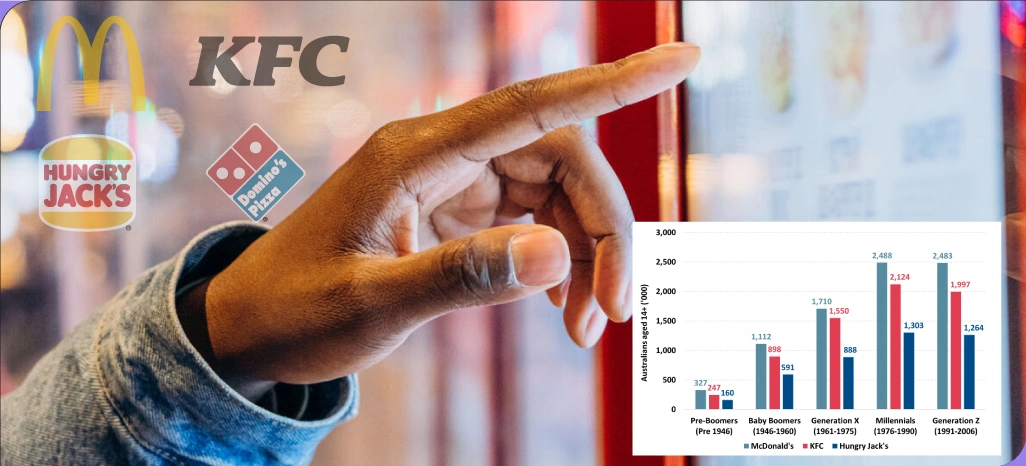
Australia's fast food market has experienced significant growth over the years, driven by a diverse population with varied tastes and preferences. According to market reports, the fast food industry in Australia is worth billions, with major players like McDonald's, KFC, Hungry Jack's, and Domino's leading the charge. In addition to these international chains, there is a growing presence of local fast-food businesses catering to niche markets, including vegan, gluten-free, and health-conscious consumers.
The industry is defined not only by its large-scale operations but also by ever-changing consumer demands. Fast food chains continuously update their menus to introduce new items, accommodate dietary trends, and react to customer feedback. This dynamic nature of the fast food market makes it crucial for businesses to stay informed about the latest trends and competitor strategies.
The Role of Data Scraping in the Fast Food Industry
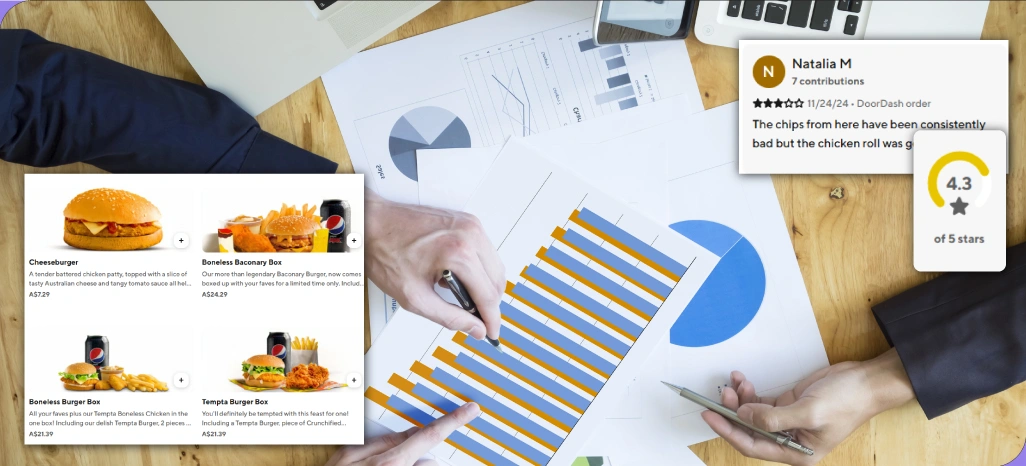
Data scraping is the process of extracting large amounts of data from various websites and online platforms. In the fast food industry, scraping involves collecting information from fast food chain websites, food delivery apps, and third-party review platforms. The primary goal is to gather insights into the fast food items being sold, their prices, seasonal promotions, and customer preferences.
By scraping fast food data, businesses can:
- Track Menu Changes: Fast food chains frequently update their menus, introducing new items or discontinuing old ones. Scraping data allows businesses to monitor these changes in real time and adapt their offerings accordingly.
- Analyze Pricing Strategies: Price competitiveness is a key factor in the fast food industry. Food delivery data scraping allows businesses to gain insights into pricing strategies and identify opportunities to optimize their pricing models.
- Monitor Consumer Preferences: Data scraping helps businesses understand which items are trending, popular, or receiving negative feedback. Businesses can align their menus with consumer demands by analyzing customer reviews, social media mentions, and sales data.
- Competitor Benchmarking: Businesses can use scraped data to compare their offerings. This includes analyzing menu composition, pricing, and promotional strategies. By benchmarking against competitors, companies can identify gaps and opportunities in the market.
- Stay Ahead of Market Trends: Food data scraping allows businesses to identify emerging trends, such as the rise of plant-based menu items or new dietary preferences. Understanding these trends enables businesses to innovate and stay relevant in an increasingly competitive market.
Benefits of Scraping Fast Food Item Data in Australia
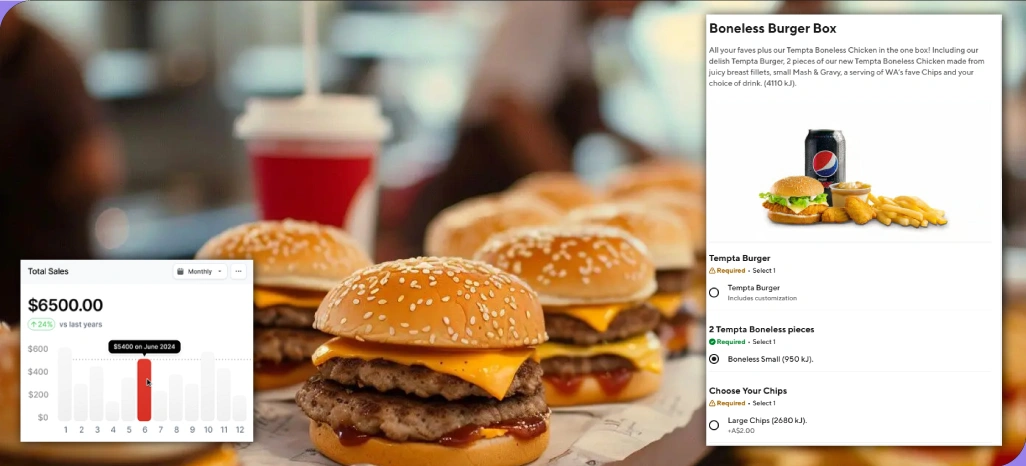
Menu scraping for Australian restaurants provides businesses with a wealth of insights that can drive better decision-making and operational efficiency. The following are some of the key benefits:
1. Improved Product Development: Fast food chains constantly experiment with new recipes and menu items to meet changing customer preferences. By scraping data from a wide range of fast-food providers, companies can identify successful trends and learn what items are being introduced. This information can help them develop new products that cater to customer tastes and stay ahead of the competition.
2. Enhanced Customer Experience: Scraped data allows fast food chains to better understand their customers' preferences. By analyzing customer reviews and feedback, businesses can identify common complaints and areas for improvement. This could include offering more vegetarian options, adjusting portion sizes, or enhancing the flavor profiles of popular items. Personalizing the customer experience in this way can significantly boost customer loyalty and satisfaction.
3. Optimized Marketing Campaigns: Marketing strategies in the fast food industry often rely on data-driven decisions to target the right audience. By scraping data from food delivery apps, social media platforms, and review sites, businesses can determine which promotions are working and which are not. This allows them to optimize their marketing efforts, tailor promotions to the most relevant customer segments, and improve conversion rates.
4. Competitive Advantage: The fast food market in Australia is highly competitive, with numerous brands vying for consumer attention. Data scraping gives businesses a clear competitive advantage by providing them with insights into their competitors' strategies. By monitoring competitors' menus, pricing, and marketing tactics, businesses can better position themselves in the market and develop unique selling propositions (USPs) that set them apart.
5. Cost Efficiency: Scraping data is a cost-effective way to gather valuable market intelligence compared to traditional surveys or focus groups. With automated scraping tools, businesses can quickly collect and analyze large amounts of data without the need for expensive research teams or manual labor. This makes it an ideal solution for fast-paced industries like fast food, where real-time insights are crucial for staying competitive.
Popular Fast Food Chains in Australia and Their Menus
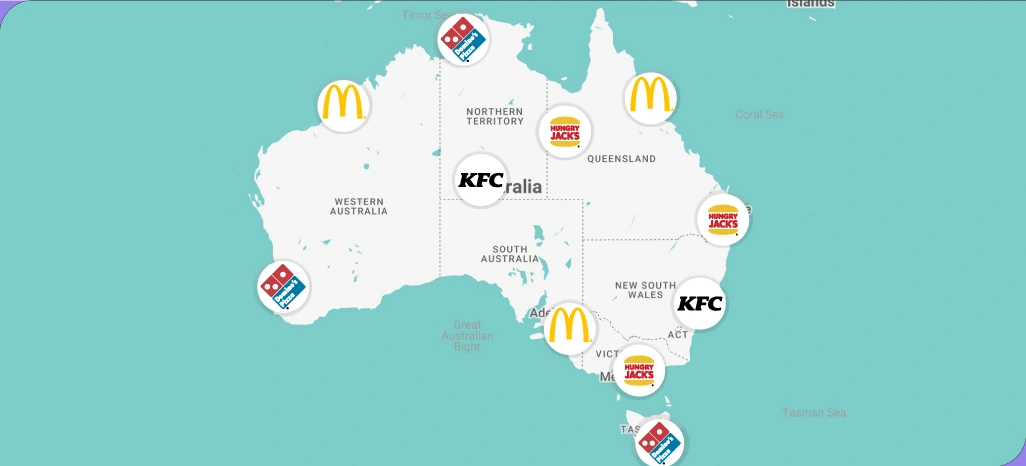
Australia is home to a wide range of fast food chains, both international and local. Below are some of the most prominent chains and their popular menu items:
McDonald's
McDonald's is one of Australia's largest and most recognizable fast food brands. Its menu includes burgers, chicken nuggets, salads, and breakfast items. McDonald's is also known for its limited-time promotions and seasonal offerings, such as the McRib and specialty burgers. By scraping McDonald's menu data, businesses can track the introduction of new items and pricing changes.
KFC
KFC is famous for its fried chicken, and its menu in Australia includes buckets, wraps, burgers, and sides like coleslaw and mashed potatoes. KFC frequently introduces limited-time offers, such as new chicken flavors or seasonal sides. Scraping KFC's menu data can provide insights into consumer preferences for different chicken styles and combinations.
Hungry Jack's
As the Australian counterpart to Burger King, Hungry Jack's offers a variety of burgers, fries, and shakes. The chain is known for its flame-grilled burgers and its special promotions. Data scraping can help track the introduction of new items and the effectiveness of different marketing campaigns.
Domino's
Domino's is a leader in the pizza segment, with an extensive menu of pizzas, sides, and desserts. The brand also offers customization options, allowing customers to create unique pizzas. Scraping Domino's menu and promotional data provides businesses with a clear picture of the latest pizza trends and customer preferences.
Local Fast Food Brands
In addition to the international chains, Australia is home to several local fast-food brands that cater to specific tastes. These include brands like Grill'd (known for gourmet burgers), Schnitz (specializing in schnitzels), and Oporto (famous for its Portuguese-style chicken). Scraping data from these brands provides insights into niche market segments and emerging food trends.
Challenges of Scraping Fast Food Item Data
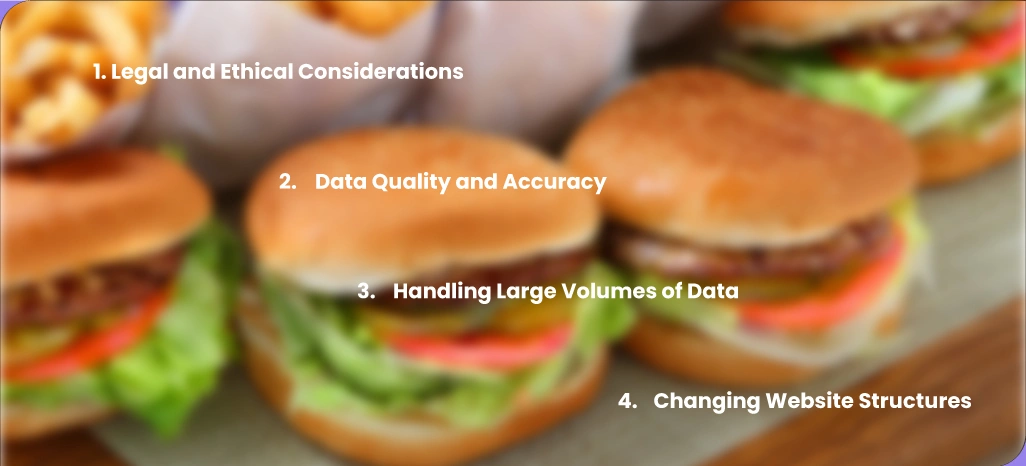
While data scraping offers numerous benefits, it also comes with its own set of challenges. Some of the common issues include:
- Legal and Ethical Considerations: It's essential to ensure that data scraping complies with legal and ethical guidelines. Some websites have terms of service prohibiting scraping, so obtaining permission or using scraping tools that respect the website's policies is essential.
- Data Quality and Accuracy: Not all data collected through scraping is accurate or relevant. Businesses must ensure that their data is clean, accurate, and up-to-date. This may involve using advanced filtering techniques and regular data validation.
- Handling Large Volumes of Data: Fast food data scraping often involves collecting large volumes of data from multiple sources. Businesses must have the infrastructure and tools to store, process, and analyze this data effectively.
- Changing Website Structures: Websites and apps frequently update their design and structure, which can break existing scraping scripts. Businesses must be prepared to update their scraping tools regularly to handle these changes.
Conclusion
Scraping fast food item data in Australia gives businesses a wealth of insights that can drive product development, marketing strategies, and competitive advantage. By leveraging this data, companies can stay ahead of market trends, optimize their offerings, and enhance the customer experience. While challenges are involved, the benefits far outweigh the risks, making data scraping an essential tool for businesses in the fast food industry. Whether tracking menu changes, analyzing pricing strategies, or identifying emerging trends, data scraping offers valuable insights to help businesses succeed in the competitive Australian fast-food market.
Transform your retail operations with Retail Scrape Company’s data-driven solutions.
Harness real-time data scraping to understand consumer behavior, fine-tune pricing strategies, and outpace competitors. Our services offer comprehensive pricing optimization and strategic decision support. Elevate your business today and unlock maximum profitability. Reach out to us now to revolutionize your retail operations!
